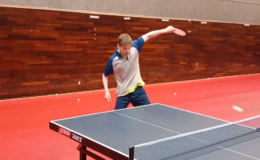Courtesy of Seth Pech of PechPong
Quick Tips with links
– 00:24 How to improve backhand power from close to the table in a game-like situation
– 00:37 Tips for improving backhand flip and making it more versatile in a match
– 00:56 Techniques for better forehand flips and progressing your defense as an offensive player
– 03:05 When going for stronger shots, avoid flattening out your stroke and getting less spin, which can lead to a flatter and less consistent ball trajectory.
– 03:23 Using a return board can help improve your timing, encourage longer swings with your wrist, and enhance muscle memory for stronger and faster swings.
– 04:45 Improve your wrist, forearm, and shoulder strength through gym exercises, as it can significantly contribute to accelerating the racket and generating more power.
– 06:25 Incorporate wrist movement to reach further during backhand shots.
– 06:34 Mix distance and use wrist or forearm-oriented backhand flip based on ball depth.
– 07:28 Improve forehand flip by waiting for the ball to come closer for better wrist and forearm action.
– 09:49 Retraining myself to touch the ball at the right moment during drills.
– 10:41 Building upon the blocking drill by using the forehand side to be more aggressive and counter Loop.
– 11:34 Tips to improve the drill: keeping your hand in front, waiting and observing before making a decision, and avoiding taking too big of a swing on the forehand side.
Techniques to Improve Backhand and Forehand Flips in Table Tennis
Introduction
Welcome to this comprehensive guide on improving your backhand and forehand flips in table tennis. In this article, we will explore effective techniques, practice drills, and valuable insights from experienced players to help you enhance your gameplay. Whether you’re looking to add power and versatility to your backhand flips or improve your timing and accuracy in forehand flips, these tips will take your table tennis skills to the next level.
Enhancing Backhand Flips
To improve your backhand flips, it’s important to focus on technique and utilize the full potential of your wrist. Here’s a breakdown of the key techniques and drills:
1. **Wrist Action:** Incorporate wrist action in your backhand flips to reach the ball more effectively and generate greater power. By using your wrist as a pivot point, you can execute successful flips even with short balls.
2. **Distance Variation Drill:** Set up a box of balls at varying distances, including short and normal short ones. Practice flipping the balls with the appropriate technique based on their distance, using a combination of forearm and wrist movement.
3. **Offensive Defense:** Develop offensive defense skills to maintain a well-rounded playing style. Gradually introduce aggressive shots and attacking opportunities into your game while maintaining strong defensive capabilities.
By implementing these techniques, you’ll enhance your backhand flip, improving power, versatility, and adaptability.
Mastering Forehand Flips
The forehand flip is a crucial offensive stroke that requires proper timing and technique. Follow these tips to master your forehand flips:
1. **Timing is Key:** Wait for the ball to come closer before executing the forehand flip. This allows you to achieve better form and utilize your wrist effectively for increased power and spin.
2. **Break Habits:** If you have a habit of touching the ball too early during a forehand flip, focus on breaking that habit. Consistent practice and repetition will help you develop the correct timing.
3. **Serve Variation Drill:** Practice with a partner who serves long balls to your backhand and short balls to your forehand. This drill will improve your adaptability and decision-making skills.
4. **Learn from Experts:** Seek advice from experienced players who excel in forehand flipping. Watch instructional videos and learn from their insights and techniques to refine your own skills.
By focusing on timing, breaking habits, and incorporating tips from skilled players, you’ll enhance your forehand flip and transform defensive situations into offensive opportunities.
From Defense to Offense: Blocking and Counter Looping
As an offensive player, it’s crucial to transition smoothly from a defensive position to an offensive one. The drill of blocking and counter looping is an effective way to develop this skill. Here’s how to approach it:
1. **Block and Counter Loop:** When your opponent loops the ball, block it if it goes to your backhand and execute a counter loop if it goes to your forehand. This drill helps you practice quick transitions and maintain control.
2. **Hand Placement and Observation:** Keep your hand in front and carefully observe your opponent’s shot before deciding on your response. After executing your shot, return to a ready position with your hand in front again.
3. **Controlled Forehand Swing:** Avoid excessive swings during the counter loop. Keep your forehand in front, initiate the shot from your body and legs, and minimize the backswing to improve timing and accuracy.
4. **Utilize Opponent’s Energy:** Instead of relying solely on your own energy, learn to utilize your opponent’s energy by timing your shots with their momentum. This will add power and unpredictability to your counter loops.
By practicing the blocking and counter looping drill and focusing on hand placement, controlled swings, and utilizing your opponent’s energy, you can develop a more aggressive and effective game, turning defensive situations into offensive opportunities.
Conclusion
Improving your backhand and forehand flips in table tennis requires a combination of proper technique, practice drills, and learning from experienced players. By incorporating wrist action in your backhand flips and waiting for the ball in forehand flips, you can enhance the power and accuracy of your shots. Breaking habits and consistently practicing the correct technique will help you improve your timing and touch on the ball.
Additionally, the drill of blocking and counter looping will enable you to transition from a defensive position to an offensive one, allowing you to capitalize on your opponent’s shots. Remember to focus on hand placement, controlled swings, and utilizing your opponent’s energy. By implementing these techniques and drills, you can elevate your game and become a more formidable player in table tennis.
So, whether you’re striving to improve your backhand power, enhance your flip technique, or develop offensive defense skills, these techniques and tips will take your table tennis skills to new heights. Practice diligently, stay focused, and enjoy the journey of becoming a better player. Best of luck on your table tennis adventure!






